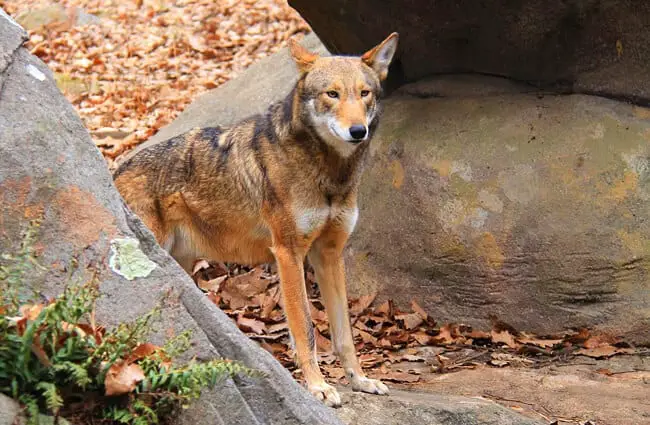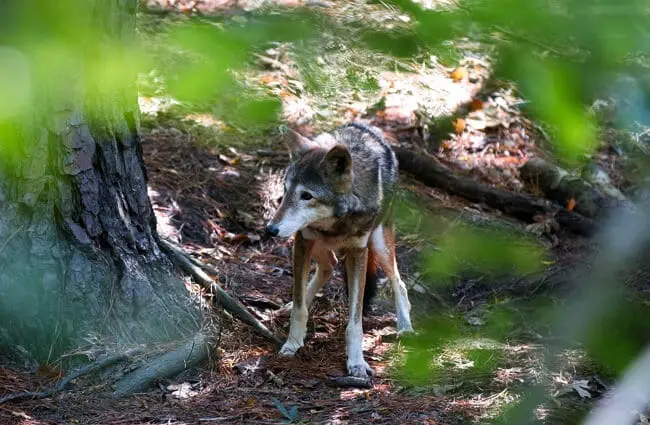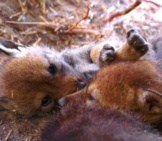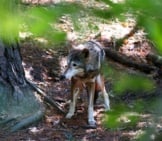Red wolves are a Critically Endangered species of wolf that was originally native to the southeast United States. They are sometimes referred to as “Florida black wolves,” or “Mississippi Valley wolves.” There is some scientific debate over the taxonomic classification of the red wolf as a separate species. According to U.S. Fish & Wildlife, there are estimated to be as few as 44 red wolves in the wild, and just 3 breeding pairs. Read on to learn about the red wolf.
Description of the Red Wolf
Perhaps the easiest way to describe these canines is to compare them with their two closest relatives. They look like the missing link between gray wolves and coyotes. They are approximately midway between the sizes of the two species, and usually measure around 5 ft. long and 50 – 85 lbs. on average. Their fur has a reddish hue to it, with lighter coloration on the face and underbelly.
Interesting Facts About the Red Wolf
These critically endangered canines desperately need our help. The small population remaining in North Carolina has become even smaller in the past five years. Learn more about these creatures, and why they deserve protection, below.
- Keystone Species – Much like sea otters, red wolves are a keystone species. This means that they greatly affect the health of the ecosystem around them. So, when red wolf populations decrease, prey populations increase. Also, disease increases, vegetation decreases, and many creatures die off.
- Nuisance Removal – Another strong benefit to a healthy red wolf population is the decline of nuisance species. Red wolves feed on deer, invasive nutria, small rodents, and raccoons. These species are known to cause crop and equipment damage to agricultural areas.
- Secondary Benefits – Beside the direct benefit of reducing pests, these canines also feed on animals that reduce the populations of species of interest. For example, by hunting raccoons, red wolves reduce the number of raccoons preying upon endangered sea turtle eggs. They also reduce populations of animals that prey on game bird species.
- Healthy Game Populations – Deer are beyond plentiful, in fact, they can be quite a nuisance in some areas. While red wolves will prey on young deer, they also hunt old and sick animals. This helps strengthen the gene pool, by weeding out the weakest animals. While hunters reduce the deer populations, they strive to take the biggest and strongest animals, not the weakest, which does nothing to help create healthier populations.
Habitat of the Red Wolf
Prior to their extirpation, these wolves ranged a large portion of the southeast United States. Experts believe that, during this time, they used a much wider range of habitats than they do currently. Today they exist only in the Alligator River National Wildlife Refuge. In this area, they prefer to use coastal prairie marshes, agricultural fields, and swamps. They also use pine forests, evergreen forests, and wetlands.
Distribution of the Red Wolf
The only population of wild red wolves left in the world resides in Alligator River National Wildlife Refuge in the eastern portion of North Carolina. Prior to European settlement, this species ranged from Pennsylvania to Texas, and as far south as Florida. A number of zoos have successful captive breeding programs. In particular, the Point Defiance Zoo & Aquarium in Washington spearheaded this effort.
Diet of the Red Wolf
Before becoming so scarce, these wolves primarily fed on smaller mammals. They hunt larger animals, like deer, when opportunity arises as well. Some of their primary prey sources are rabbits, rats, mice, nutria, raccoon, and deer. They are social and hunt as a group, but not to the extent of their relatives, the gray wolves.
Red Wolf and Human Interaction
At one point, humans wiped out the entire wild red wolf population. As an effort to save the species prior to their extinction in the wild, scientists captured 400 animals from the remaining populations. Of those animals only 14 were viable breeding stock of pure genetics. The program used these wolves to set up a successful captive breeding program.
Numerous attempts to reintroduce the wolves into the wild failed, with the only successful program being the current one in North Carolina. Sadly, their numbers have fluctuated wildly. Today they remain threatened by habitat loss, poaching, and mismanagement. Authorities have even granted permits to private landowners, to kill wild red wolves in the past few years.
Domestication
Red wolves have not been domesticated in any way.
Does the Red Wolf Make a Good Pet
No, do not make good pets. These canines are critically endangered, and every individual is important for the survival of the species. It is highly illegal to own a red wolf.
Red Wolf Care
In a zoological setting, red wolves are used for breeding purposes, or as ambassadors to the plight of the species. Ambassador animals are typically too inbred or infertile, making them poor candidates for breeding. For animals intended for release, it is important that they receive minimal human contact.
Their diet closely replicates what their wild counterparts eat in the wild. Before attempting to reintroduce captive bred wolves into the wild, they stay on St. Vincent National Wildlife Refuge, an island that allows them to learn how to survive in the wild.
Behavior of the Red Wolf
These wolves live in small family groups. Pairs are monogamous, and will breed with the same mate until that mate dies. Parents and their offspring make up most packs, but those offspring will disperse as they reach sexual maturity. When the cubs leave the pack the will either range alone, or join small non-breeding groups. Once a suitable pair bonds they will find and establish their own territory.
Reproduction of the Red Wolf
Breeding occurs in February and March. The female will give birth after approximately 2 months to anywhere between 2 and 10 pups. Adults from previous litters that have not dispersed yet will help feed and protect the new pups. Like most canines, weaning occurs around 8 weeks of age. The pups reach full size when they are 1-year-old, and reach sexual maturity at 2 years of age.











![Red Angus Closeup of a beautiful Red Angus cowPhoto by: U.S. Department of Agriculture [pubic domain]https://creativecommons.org/licenses/by/2.0/](https://animals.net/wp-content/uploads/2020/03/Red-Angus-4-238x178.jpg)












![Red Angus Closeup of a beautiful Red Angus cowPhoto by: U.S. Department of Agriculture [pubic domain]https://creativecommons.org/licenses/by/2.0/](https://animals.net/wp-content/uploads/2020/03/Red-Angus-4-100x75.jpg)

